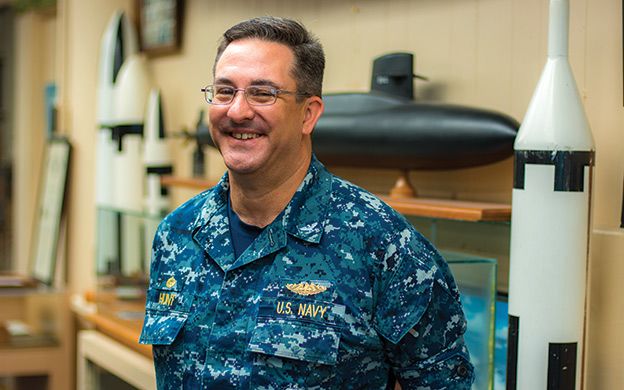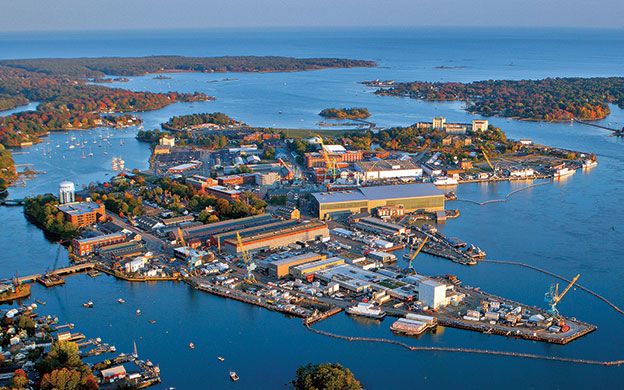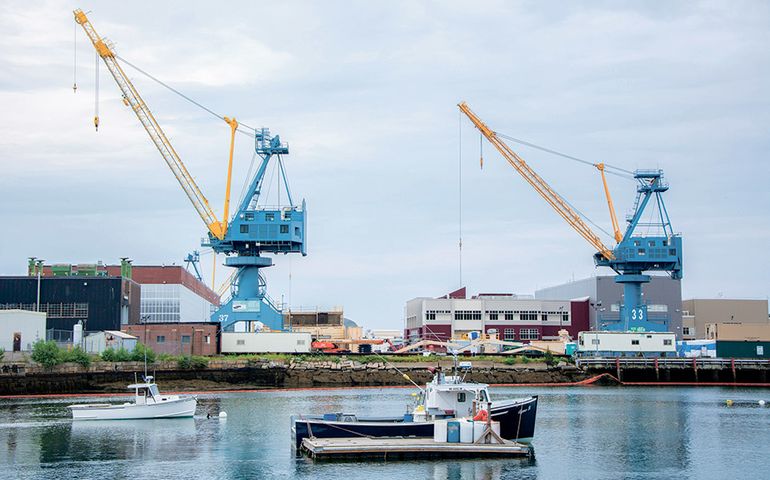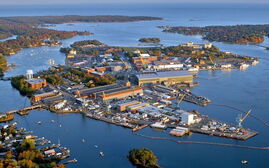Portsmouth Naval Shipyard's enviable challenge: It's flooded with applications
Like the nuclear-powered submarines it services for Uncle Sam, Maine's Portsmouth Naval Shipyard is a force to be reckoned with. Its 2016 economic impact is estimated at $756 million, including $496.2 million in salaries for civilians and $43.2 million for military personnel.
Spread across 300 acres on a group of islands in the Piscataqua River and linked by two bridges to Kittery, PNS is the oldest of four remaining naval shipyards — with a reputation for delivering ahead of schedule at or below budget, like the USS Providence, which finished 23 days early in April.
Established by the federal government in 1800, Portsmouth Naval Shipyard built submarines until 1971, when it switched to maintaining, repairing and modernizing nuclear submarines. “It's a 19th-century industry that's managed to stay relevant,” says shipyard historian Joe Gluckert, adding that vessels leaving the yard today are “state of the art, the finest ships a Navy can have.”
Economic impact
Unknown even to many Mainers, the government-owned and -operated facility is one of the state's stop employers, with 5,430 civilians working at the shipyard out of 6,329 total at the base. The Seacoast Shipyard Association, set up in 1964 to protect the interests of the yard and surrounding communities, estimates the 2016 economic impact at $756 million. The figure includes $496.2 million in salaries for civilians and $43.2 million for military personnel, $76.6 million in goods and services purchased and $140.6 million in contracted facility services.
Capt. David Hunt, the shipyard's 50-year-old commander, puts the economic impact as high as $1 billion, counting secondary and tertiary effects. “It's pretty powerful, a pretty big economic engine, when you look at it, for the area.” A third of the way into his three-year posting, Hunt is the yard's 85th commander, going back to “Old Ironsides” commander Isaac Hull in 1812.
Like the more famous General Dynamics Corp.'s Bath Iron Works, Portsmouth Naval Shipyard has its own storied history and strategic importance. Established two decades before Maine became a state, the shipyard has weathered two world wars, base closure threats, and a Maine-New Hampshire border dispute resolved by a 2001 U.S. Supreme Court ruling in Maine's favor. (The vote was 8-0 with New Hampshire native David Souter abstaining.) Mainers make up the lion's share of civilian employees (3,810), led by the nearby towns of Sanford/Springvale (453), Kittery/Kittery Point (441) and South Berwick (348).
Among the thousands of suppliers of goods and services to the yard are a handful of Maine companies such as Cianbro, which was just awarded a $23 million contract for dry-dock repairs due to be finished by July 2019.
“The investments helps to ensure the success of that yard in the future,” says Andi Vigue, Cianbro's president and CEO. “Our little piece is tiny compared to that.” Hunt says that while there's not a preference for local suppliers, it helps to have them close by. “We're used to doing a lot of the work with the local vendors, and because of that,” he says, “they probably have a slight competitive advantage.”
Navy 'in high demand' but for how long?
In Kittery, where the Navy water tank is visible from downtown, it's not unusual to spot Navy-insignia T-shirts or baseball caps at the popular Lil's Café.
One could also say the Navy itself is in fashion these days based on the Trump administration's defense spending ambitions. It is seeking to raise the defense budget by $54 billion to $668 billion to “rebuild lost capacity and capability, to accelerate the defeat of ISIS, and to keep us safe in a more dangerous world.” The plan calls for rebuilding the Navy by restoring and improving readiness of the existing fleet and adding new vessels, including two Virginia class fast-attack subs.
“The Navy is in very high demand right now, because the country is coming out of a bad experience of protected ground commitments overseas,” says Peter H. Daly, a retired Navy vice admiral who runs the independent U.S. Naval Institute in Washington, D.C. “That makes naval power attractive. You can dial it in and dial it out. That's important because it generates some ambiguity and it keeps our potential adversaries guessing. That's why submarines are important — they're being requested by the geographic commanders at twice the rate the Navy can provide. In a market sense, if you look at the Navy as a company with products, you've got this submarine product which is in demand.”
It also helps to have support from lawmakers like U.S. Rep. Chellie Pingree, D-1st District Maine, who told Mainebiz in an email that one of her priorities in Congress is supporting the shipyard's workforce: “These workers face long hours, demanding technical work, and often long-distance travel. We need to do what we can to help them recruit, retrain and reward their workforce for the contributions to our nation. Supporting our federal workforce and avoiding government shutdowns are key in this regard.”
She added that she is always looking for funding opportunities in the Military Construction portion of the budget and “trying to ensure that funds are fairly distributed” to the yard.
But having Uncle Sam as its only shareholder and customer and being in blue-state territory also makes PNS vulnerable to political headwinds. While it ended up being spared from the Base Realignment and Closure process in 2005, another round as is currently being demanded by a group of scholars could put it back on the endangered list, as John Joyal knows from his 40-plus years at the yard.
“Things can change in a heartbeat in this country,” says Joyal, a former welder and trainer who is chairman of the Seacoast Shipyard Association. His son is an apprentice electrician.
Building blocks
As employers across Maine struggle to lure young local talent, PNS is flooded with applications, twice what's needed for engineers and three to four times for apprenticeships. Many jobseekers are local, due in part to the shipyard's cooperation with community colleges and outreach to 14,000 students a year through programs like SeaPerch, which teaches kids from sixth grade through college how to build model submarines.
New hires at the yard start work on submarine mockups, via multi-disciplinary teams known as learning centers. “It's a safe place to fail,” Hunt says, “so you can try innovative things.” Employees with suggestions for improvements while on the mock-up are encouraged to speak up, and management listens. While workers are more engaged as a result, he finds it “extremely challenging” to manage today's more junior workforce — 60% have less than five years experience. His priorities, he adds, are safety and quality.
The next few months look to be busy, with $720 million in expected work this year and 6,000 shipyard workers in the next two and three years, according to Hunt. In the next two years, he hopes to get the shipyard ready for Virginia-class maintenance: “Only two of our docks here are Virginia-class capable, so we are laying the groundwork right now to make us a three-dock Virginia-class capable.” An eight- to 10-year process, it won't be completed on his watch, but that's not a concern. “Maintaining that vision for the shipyard so they're viable far into the future is what's important.”
Read more
Portsmouth Naval Shipyard looking to fill 800 new jobs in 2018



















Comments